 Many home video game consoles have gone down in history as being too far ahead of their time, or being too underpowered by the time they reached the market. But the Atari 7800 – a high-end but low-priced system concocted by Atari to compete with such systems as the ColecoVision/ADAM and the growing share of the gaming market being engulfed by the home computer market – was truly a machine that was in the wrong place at the wrong time.
Many home video game consoles have gone down in history as being too far ahead of their time, or being too underpowered by the time they reached the market. But the Atari 7800 – a high-end but low-priced system concocted by Atari to compete with such systems as the ColecoVision/ADAM and the growing share of the gaming market being engulfed by the home computer market – was truly a machine that was in the wrong place at the wrong time.
The 7800 was created and engineered around 1985 by General Computer, the firm to whom  Atari had been outsourcing the bulk of game development for the 5200 and 2600, and it looked like Atari had learned its lessons from the marketing debacle that was the 5200 SuperSystem. Perhaps its most compelling feature, aside from its price, was the fact that the 7800 was backward-compatible (or, at least, was supposed to be) with the ubiquitous Atari 2600. The 5200 had skipped this obvious concession to the hundreds of thousands of 2600 owners, and by offering an inexpensive 2600 Expansion Module for its machine before Atari got around to doing the same for the 5200, Coleco took the gold, winning the hearts of consumers everywhere by not forcing them to start from scratch and abandon their large 2600 game libraries. The 7800 was designed to avoid that problem altogether, and no module was necessary: the cartridges for both machines were identically shaped. Everything went into the same slot.
Atari had been outsourcing the bulk of game development for the 5200 and 2600, and it looked like Atari had learned its lessons from the marketing debacle that was the 5200 SuperSystem. Perhaps its most compelling feature, aside from its price, was the fact that the 7800 was backward-compatible (or, at least, was supposed to be) with the ubiquitous Atari 2600. The 5200 had skipped this obvious concession to the hundreds of thousands of 2600 owners, and by offering an inexpensive 2600 Expansion Module for its machine before Atari got around to doing the same for the 5200, Coleco took the gold, winning the hearts of consumers everywhere by not forcing them to start from scratch and abandon their large 2600 game libraries. The 7800 was designed to avoid that problem altogether, and no module was necessary: the cartridges for both machines were identically shaped. Everything went into the same slot.
Sadly, the Tramiel family’s takeover of Atari from Warner Bros. put the 7800 into an R&D deep freeze. The machine didn’t see the light of day until 1987, by which time Nintendo ruled the world with the NES. And while the NES was basking in the killer-app glow of games like the Super Mario Bros. series, The Legend Of Zelda and a little thing called Tetris, the 7800 was still leaning on such early-80s Atari staples as Xevious, Ms. Pac-Man and Pole Position II. The 7800 became the Rip Van Winkle of the home video game race: a system that, through no fault of its own, had slept too long.
 [jwcatpostlist orderby=title order=asc includecats=17]
[jwcatpostlist orderby=title order=asc includecats=17]
 The Game: Intrepid plumbers Mario and Luigi have fallen back on Mario’s original mandate – rescuing the damsel – as they journey through the kingdom, battling Koopas and braving falls from dizzying heights, all to
The Game: Intrepid plumbers Mario and Luigi have fallen back on Mario’s original mandate – rescuing the damsel – as they journey through the kingdom, battling Koopas and braving falls from dizzying heights, all to  rescue the princess (who, as always, seems to be in another castle). In Duck Hunt things are a bit more normal – you’re just trying to nail some ducks in the wild, with the help and encouragement (and, if you let one get away, derisive laughter) from your trusty huntin’ dawg. (Nintendo, 1985)
rescue the princess (who, as always, seems to be in another castle). In Duck Hunt things are a bit more normal – you’re just trying to nail some ducks in the wild, with the help and encouragement (and, if you let one get away, derisive laughter) from your trusty huntin’ dawg. (Nintendo, 1985)
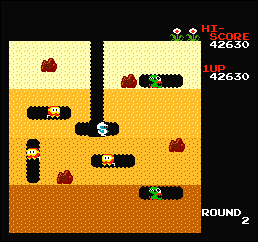 The Game: Who said landscaping was easy? You are Dig Dug, an intrepid gardener whose soil is infested with pesky Pookas and fire-breathing Fygars. You’re armed with your trusty pump, which you can use to inflate your enemies until, finally, they blow up. But both the Pookas and Fygars can crawl through the ground and can pop out into your tunnels, and if a Fygar sneaks up behind you, he can toast you if you’re not careful. (Namco, 1985)
The Game: Who said landscaping was easy? You are Dig Dug, an intrepid gardener whose soil is infested with pesky Pookas and fire-breathing Fygars. You’re armed with your trusty pump, which you can use to inflate your enemies until, finally, they blow up. But both the Pookas and Fygars can crawl through the ground and can pop out into your tunnels, and if a Fygar sneaks up behind you, he can toast you if you’re not careful. (Namco, 1985)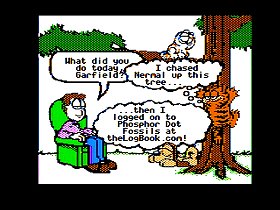 The Game: Using a simple drag-and-drop system (controlled by keyboard, mouse or joystick), put the elements of an original Garfield comic into place, including everyone’s favorite big orange cat, Odie, Jon, Nermal and all the fixtures and fittings of home (including a big burger and some lasagna). Then position speech balloons in the appropriate place, containing either signature Garfield catchphrases or your own words. Print and/or save to disk, repeat ad nauseum, and avoid Jim Davis’s lawyers thereafter! (Developmental Learning Materials, 1985)
The Game: Using a simple drag-and-drop system (controlled by keyboard, mouse or joystick), put the elements of an original Garfield comic into place, including everyone’s favorite big orange cat, Odie, Jon, Nermal and all the fixtures and fittings of home (including a big burger and some lasagna). Then position speech balloons in the appropriate place, containing either signature Garfield catchphrases or your own words. Print and/or save to disk, repeat ad nauseum, and avoid Jim Davis’s lawyers thereafter! (Developmental Learning Materials, 1985) The Game: You are the Doctor’s companion, separated from the Time Lord during an attempt to save the Doctor’s old friend, King Varangar. When you come to, the Doctor is nowhere around, you’re unarmed, and you’re surrounded by deadly swamps, war zones, and hostile alien soldiers. Your life expectancy away from the TARDIS isn’t looking terribly good – and even if you can reunite with the Doctor, escaping from planet Quantain won’t be easy. (BBC Software, 1985)
The Game: You are the Doctor’s companion, separated from the Time Lord during an attempt to save the Doctor’s old friend, King Varangar. When you come to, the Doctor is nowhere around, you’re unarmed, and you’re surrounded by deadly swamps, war zones, and hostile alien soldiers. Your life expectancy away from the TARDIS isn’t looking terribly good – and even if you can reunite with the Doctor, escaping from planet Quantain won’t be easy. (BBC Software, 1985)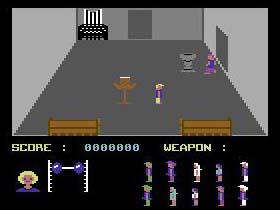 The Game: Find Jason Voorhees and destroy him before he slaughters your friends in this game based on the popular horror movie franchise. People will definitely die; the only questions are who, when, and by whom. (Dormark, 1985)
The Game: Find Jason Voorhees and destroy him before he slaughters your friends in this game based on the popular horror movie franchise. People will definitely die; the only questions are who, when, and by whom. (Dormark, 1985) The Game: Supernarural, paranormal investigations and eliminations are the order of the day, as you open your own ghost busting franchise. You start with a finite budget and have to make some savvy choices about vehicles and gear; then it’s time to strap on a proton pack, get behind the wheel of the Ectomobile, and cruise around the Big Apple watching for flashing red buildings (telltale signs of a poltergeist party in progress). When you arrive on the scene, a little bit of driving is required, which gives you the chance to mop up a few free-roaming full-torso vaporous apparitions off the streets,
The Game: Supernarural, paranormal investigations and eliminations are the order of the day, as you open your own ghost busting franchise. You start with a finite budget and have to make some savvy choices about vehicles and gear; then it’s time to strap on a proton pack, get behind the wheel of the Ectomobile, and cruise around the Big Apple watching for flashing red buildings (telltale signs of a poltergeist party in progress). When you arrive on the scene, a little bit of driving is required, which gives you the chance to mop up a few free-roaming full-torso vaporous apparitions off the streets, 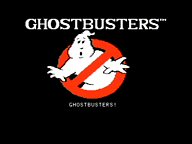 before you arrive at your destination and try to trap a ghost without crossing the streams. All the while, supernatural forces are converging on a site formerly known as the temple of Zuul, and when the paranormal powers there reach a critical mass, it’s time for roasted marshmallow – or the end of the world. (Activision, 1985)
before you arrive at your destination and try to trap a ghost without crossing the streams. All the while, supernatural forces are converging on a site formerly known as the temple of Zuul, and when the paranormal powers there reach a critical mass, it’s time for roasted marshmallow – or the end of the world. (Activision, 1985)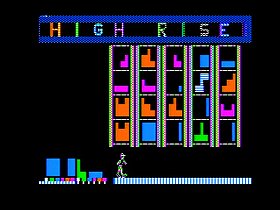 The Game: Think of it as the anti-Tetris. Five hoppers dispense geometric shapes on your command. As Barnaby, you move the pieces into place to build the most stable structure you possibly can, and if you manage to build a high enough tower, you climb to the top and advance to the next level. The first level’s shapes are fairly easy, but as you advance through levels, the pieces take on stranger and stranger shapes – and balancing them becomes harder. In later levels, you start rounds with oddball shapes already in place on the playing field, making your task that much harder. The game ends when the timer runs out without the completion of a stable structure. (Micro Learn, 1985)
The Game: Think of it as the anti-Tetris. Five hoppers dispense geometric shapes on your command. As Barnaby, you move the pieces into place to build the most stable structure you possibly can, and if you manage to build a high enough tower, you climb to the top and advance to the next level. The first level’s shapes are fairly easy, but as you advance through levels, the pieces take on stranger and stranger shapes – and balancing them becomes harder. In later levels, you start rounds with oddball shapes already in place on the playing field, making your task that much harder. The game ends when the timer runs out without the completion of a stable structure. (Micro Learn, 1985) The Game: Put your money where your fangs are in this monster mash-up that pits twelve different types of creatures against each other in the ultimate battle for survival. Arm your creature with the best weapons and armor to prepare him for games of Capture the Flag, Tournament-Style Battles, or an all out invasion. (Electronic Arts, 1985)
The Game: Put your money where your fangs are in this monster mash-up that pits twelve different types of creatures against each other in the ultimate battle for survival. Arm your creature with the best weapons and armor to prepare him for games of Capture the Flag, Tournament-Style Battles, or an all out invasion. (Electronic Arts, 1985)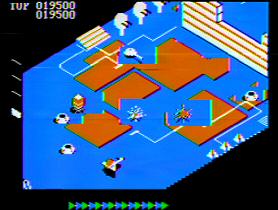 The Game: As the pilot of a lone fighter infiltrating a spaceborne fortress, your mission is simple – survive long enough to vanquish the evil Super Zaxxon robot hidden deep within the fortress, and take out as much of the defenses as you can in the meantime. (Sega, 1985)
The Game: As the pilot of a lone fighter infiltrating a spaceborne fortress, your mission is simple – survive long enough to vanquish the evil Super Zaxxon robot hidden deep within the fortress, and take out as much of the defenses as you can in the meantime. (Sega, 1985) The Game: The raging battle between the Autobots and Decepticons continues in this exclusive title for the Commodore 64 computer. Take control of five different Transformers in the Autobots’ quest for Energon. (Ocean Software, 1985)
The Game: The raging battle between the Autobots and Decepticons continues in this exclusive title for the Commodore 64 computer. Take control of five different Transformers in the Autobots’ quest for Energon. (Ocean Software, 1985) Many home video game consoles have gone down in history as being too far ahead of their time, or being too underpowered by the time they reached the market. But the Atari 7800 – a high-end but low-priced system concocted by Atari to compete with such systems as the ColecoVision/ADAM and the growing share of the gaming market being engulfed by the home computer market – was truly a machine that was in the wrong place at the wrong time.
Many home video game consoles have gone down in history as being too far ahead of their time, or being too underpowered by the time they reached the market. But the Atari 7800 – a high-end but low-priced system concocted by Atari to compete with such systems as the ColecoVision/ADAM and the growing share of the gaming market being engulfed by the home computer market – was truly a machine that was in the wrong place at the wrong time.

 The Game: Defend Earth from the comets! Halley’s Comet is on a collision course with Earth, and it’s teeming with evil aliens bent on destroying humanity. They attack the player’s ship in endless waves, even building walls in space that the player can collide with before they realize what’s happening. Power-ups can be revealed by blasting away at meteors, though catching them and accumulating their firepower in the middle of a fierce firefight is a skill unto itself. Smaller comets plunge toward the Earth at lightning speed. Any alien ships or comets that the player doesn’t destroy keep going and attack the planet; if too many are allowed to strike at Earth directly, or if the player runs out of ships, the game ends. (Taito, 1986)
The Game: Defend Earth from the comets! Halley’s Comet is on a collision course with Earth, and it’s teeming with evil aliens bent on destroying humanity. They attack the player’s ship in endless waves, even building walls in space that the player can collide with before they realize what’s happening. Power-ups can be revealed by blasting away at meteors, though catching them and accumulating their firepower in the middle of a fierce firefight is a skill unto itself. Smaller comets plunge toward the Earth at lightning speed. Any alien ships or comets that the player doesn’t destroy keep going and attack the planet; if too many are allowed to strike at Earth directly, or if the player runs out of ships, the game ends. (Taito, 1986) The Game: Monsters are running amok in cities across America… and you’re one of them! A giant lizard, a giant werewolf and a giant gorilla walk into a bar and tear it down. Monsters can compete to see who will topple tall buildings first, or they can qang up on puny defenseless human scum. It’s pretty easy to knock over buildings, and pretty easy to take a lot of damage from the armed forces who have been called out to stop the creatures. If they accrue too much damage, the monsters de-evolve to their un-mutated original human form, and require quick action (and additional quarters) to stay in the game. (Midway, 1986)
The Game: Monsters are running amok in cities across America… and you’re one of them! A giant lizard, a giant werewolf and a giant gorilla walk into a bar and tear it down. Monsters can compete to see who will topple tall buildings first, or they can qang up on puny defenseless human scum. It’s pretty easy to knock over buildings, and pretty easy to take a lot of damage from the armed forces who have been called out to stop the creatures. If they accrue too much damage, the monsters de-evolve to their un-mutated original human form, and require quick action (and additional quarters) to stay in the game. (Midway, 1986) The Game: As the commander of a sleek Solvalou fighter, you’re deep into enemy territory, shooting their disc-shaped fighters out of the sky, bombing ground installations and artillery nests, bombing tanks, and trying to destroy the mothership. As you progress further behind enemy lines, heavier aircraft and more versatile and Buy this gamedeadly ground-based defenses become the norm. Also look out for tumbling airborne mirrors – they’re impervious to your fire, but you’re toast if you fly right into them. (Nintendo [under license from Namco], 1986)
The Game: As the commander of a sleek Solvalou fighter, you’re deep into enemy territory, shooting their disc-shaped fighters out of the sky, bombing ground installations and artillery nests, bombing tanks, and trying to destroy the mothership. As you progress further behind enemy lines, heavier aircraft and more versatile and Buy this gamedeadly ground-based defenses become the norm. Also look out for tumbling airborne mirrors – they’re impervious to your fire, but you’re toast if you fly right into them. (Nintendo [under license from Namco], 1986)
 The Game: An oversized gorilla kidnaps Mario’s girlfriend and hauls her up to the top of a building which is presumably under construction. You are Mario, dodging Donkey Kong’s never-ending hail of rolling barrels and “foxfires” in your
The Game: An oversized gorilla kidnaps Mario’s girlfriend and hauls her up to the top of a building which is presumably under construction. You are Mario, dodging Donkey Kong’s never-ending hail of rolling barrels and “foxfires” in your 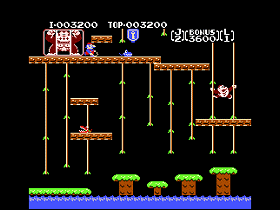 The Game: Mario has Donkey Kong in captivity, and it’s up to Donkey Kong Jr. to rescue his dad by scaling vines and chains, avoiding nasty-toothed traps and pesky birds, and reaching the key to free the great ape from Mario’s clutches. (Nintendo, 1985)
The Game: Mario has Donkey Kong in captivity, and it’s up to Donkey Kong Jr. to rescue his dad by scaling vines and chains, avoiding nasty-toothed traps and pesky birds, and reaching the key to free the great ape from Mario’s clutches. (Nintendo, 1985)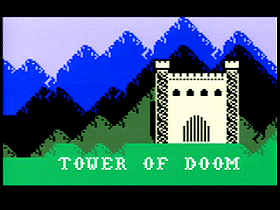
 The Game: How high can you go? Help Jumpman (Mario) save Pauline from Donkey Kong’s clutches by climbing ladders and avoiding barrels. (Ocean Software, 1986)
The Game: How high can you go? Help Jumpman (Mario) save Pauline from Donkey Kong’s clutches by climbing ladders and avoiding barrels. (Ocean Software, 1986) The Game: Various shapes consisting of four blocks each fall from the top of the screen, giving the player a short time to rotate, move (left or right only), and ultimately drop each piece into place. The goal is to put complementary shapes together, forming a solid line (or several solid lines) and leaving no gaps. Completed horizontal lines disappear from the screen, and the remaining pieces drop to the bottom. Bonus points are awarded for using the tallest piece – four blocks tall – to eliminate four lines at once. Allowing the shapes to pile up until they reach the top of the screen ends the game. (freeware, 1986)
The Game: Various shapes consisting of four blocks each fall from the top of the screen, giving the player a short time to rotate, move (left or right only), and ultimately drop each piece into place. The goal is to put complementary shapes together, forming a solid line (or several solid lines) and leaving no gaps. Completed horizontal lines disappear from the screen, and the remaining pieces drop to the bottom. Bonus points are awarded for using the tallest piece – four blocks tall – to eliminate four lines at once. Allowing the shapes to pile up until they reach the top of the screen ends the game. (freeware, 1986)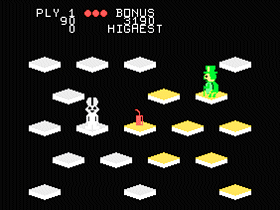 The Game: As Topper the top-hat-wearing turtle, your job is to jump from platform to platform until every platform on the screen is the same color, all without jumping into the empty space beyond the platforms. But as easy as this task may sound, it’s not that easy: rambunctious rabbits are ready to pounce on you, or at the very least keep you from reaching all of the platforms. Random explosives appear on some platforms and you have to avoid that platform until the danger has passed – and not even all of the platforms stay in one place. (Navarone Software, 1986)
The Game: As Topper the top-hat-wearing turtle, your job is to jump from platform to platform until every platform on the screen is the same color, all without jumping into the empty space beyond the platforms. But as easy as this task may sound, it’s not that easy: rambunctious rabbits are ready to pounce on you, or at the very least keep you from reaching all of the platforms. Random explosives appear on some platforms and you have to avoid that platform until the danger has passed – and not even all of the platforms stay in one place. (Navarone Software, 1986)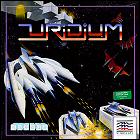 The Game: Destroy massive motherships while fighting waves of enemies and avoiding obstacles at breakneck speeds in this groundbreaking horizontal SHMUP. There’ll be time to rest when you’re dead. (Hewson, 1986)
The Game: Destroy massive motherships while fighting waves of enemies and avoiding obstacles at breakneck speeds in this groundbreaking horizontal SHMUP. There’ll be time to rest when you’re dead. (Hewson, 1986) The Game: Commanding a small fleet of sleek fighter ships, you’re up against an alien invasion, arriving in wave after unfriendly wave. Alien fighters resemble butterflies and bees, but the real prize is the handful of motherships which arriveswith each wave. Capable of taking two hits – the first weakens them and turns them dark blue, the second destroys them – the motherships also come equipped with a tractor beam with which to snare your fighters. But if one of your fighters is captured, and you can destroy the mothership which is towing it, your wayward fighter will be returned, doubling your firepower. (Namco, 1987)
The Game: Commanding a small fleet of sleek fighter ships, you’re up against an alien invasion, arriving in wave after unfriendly wave. Alien fighters resemble butterflies and bees, but the real prize is the handful of motherships which arriveswith each wave. Capable of taking two hits – the first weakens them and turns them dark blue, the second destroys them – the motherships also come equipped with a tractor beam with which to snare your fighters. But if one of your fighters is captured, and you can destroy the mothership which is towing it, your wayward fighter will be returned, doubling your firepower. (Namco, 1987) The Game: You are a marker, trying to claim as much of the playing field as you can by enclosing areas of it. Drawing your boundaries faster is safer, but yields fewer points. A slower draw, which leaves you vulnerable to attack from the Qix Dragon and the Sparx, gives you many more points upon the completion of an enclosed area. If the jumpy Qix Dragon touches your marker or an uncompleted boundary you are drawing, you lose a “life” and start again. And the Sparx, which travel only along the edges of the playing field and along the boundaries of areas of the screen you’ve already enclosed, can destroy you by touching your marker. And if you linger too long, a fuse will begin burning at the beginning of your unfinished boundary, and will eventually catch up with you. (Taito, 1987)
The Game: You are a marker, trying to claim as much of the playing field as you can by enclosing areas of it. Drawing your boundaries faster is safer, but yields fewer points. A slower draw, which leaves you vulnerable to attack from the Qix Dragon and the Sparx, gives you many more points upon the completion of an enclosed area. If the jumpy Qix Dragon touches your marker or an uncompleted boundary you are drawing, you lose a “life” and start again. And the Sparx, which travel only along the edges of the playing field and along the boundaries of areas of the screen you’ve already enclosed, can destroy you by touching your marker. And if you linger too long, a fuse will begin burning at the beginning of your unfinished boundary, and will eventually catch up with you. (Taito, 1987) The Game: As the pilot of a lone space cruiser, you must try to clear the spaceways of a swarm of free-floating asteroids, but the job isn’t easy – Newton’s laws of motion must be obeyed, even by asteroids. When you blow a big rock into
The Game: As the pilot of a lone space cruiser, you must try to clear the spaceways of a swarm of free-floating asteroids, but the job isn’t easy – Newton’s laws of motion must be obeyed, even by asteroids. When you blow a big rock into 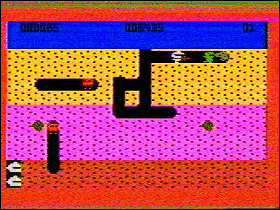 The Game: You are Dig Dug, an intrepid gardener whose soil is infested with pesky Pookas and fire-breathing Fygars. You’re armed with your trusty pump, which you can use to inflate your enemies until, finally, they blow up. But both the Pookas and Fygars can crawl through the ground and can pop out into your tunnels, and if a Fygar sneaks up behind you, he can toast you if you’re not careful. (INTV Corp., 1987)
The Game: You are Dig Dug, an intrepid gardener whose soil is infested with pesky Pookas and fire-breathing Fygars. You’re armed with your trusty pump, which you can use to inflate your enemies until, finally, they blow up. But both the Pookas and Fygars can crawl through the ground and can pop out into your tunnels, and if a Fygar sneaks up behind you, he can toast you if you’re not careful. (INTV Corp., 1987) The Game: Chef Peter Pepper is back, and he’s been served up a second helping of inedible trouble. Roaming the vast, maze-like expanses of Ray’s Diner, the chef has to round up the scattered ingredients of dinner before he finds himself on the menu. For every four screen he clears, Peter Pepper gets a chance to catch more ingredients in a bonus round (but must avoid the flashing ingredients at all costs). The chef is also still armed with his trusty pepper shaker to stun his enemies briefly, and he can still replenish his short supply of pepper when bonus items appear. (INTV Corp., 1987)
The Game: Chef Peter Pepper is back, and he’s been served up a second helping of inedible trouble. Roaming the vast, maze-like expanses of Ray’s Diner, the chef has to round up the scattered ingredients of dinner before he finds himself on the menu. For every four screen he clears, Peter Pepper gets a chance to catch more ingredients in a bonus round (but must avoid the flashing ingredients at all costs). The chef is also still armed with his trusty pepper shaker to stun his enemies briefly, and he can still replenish his short supply of pepper when bonus items appear. (INTV Corp., 1987) The Game: Commanding a small fleet of sleek fighter ships, you’re up against an alien invasion, arriving in wave after unfriendly wave. Alien fighters resemble butterflies and bees, but the real prize is the handful of motherships which arrives with each wave. Capable of taking two hits – the first weakens them and turns them dark blue, the second destroys them – the motherships also come equipped with a tractor beam with which to snare your fighters. But if one of your fighters is captured, and you can destroy the mothership which is towing it, your wayward fighter will be returned, doubling your firepower. (Atari, 1984; released circa 1987)
The Game: Commanding a small fleet of sleek fighter ships, you’re up against an alien invasion, arriving in wave after unfriendly wave. Alien fighters resemble butterflies and bees, but the real prize is the handful of motherships which arrives with each wave. Capable of taking two hits – the first weakens them and turns them dark blue, the second destroys them – the motherships also come equipped with a tractor beam with which to snare your fighters. But if one of your fighters is captured, and you can destroy the mothership which is towing it, your wayward fighter will be returned, doubling your firepower. (Atari, 1984; released circa 1987)